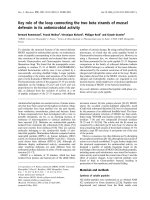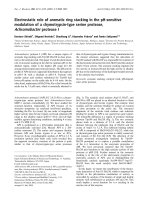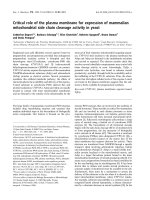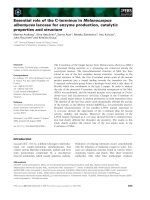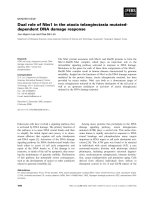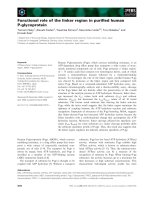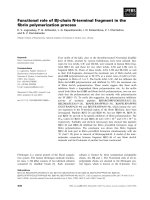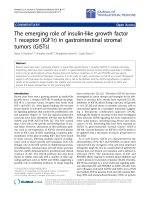Báo cáo hóa học: " The Role of Intrinsic and Surface States on the Emission Properties of Colloidal CdSe and CdSe/ZnS Quantum Dots Giovanni Morello Æ Marco Anni Æ Pantaleo Davide Cozzoli " potx
Bạn đang xem bản rút gọn của tài liệu. Xem và tải ngay bản đầy đủ của tài liệu tại đây (208.15 KB, 3 trang )
NANO EXPRESS
The Role of Intrinsic and Surface States on the Emission
Properties of Colloidal CdSe and CdSe/ZnS Quantum Dots
Giovanni Morello Æ Marco Anni Æ
Pantaleo Davide Cozzoli Æ Liberato Manna Æ
Roberto Cingolani Æ Milena De Giorgi
Received: 11 May 2007 / Accepted: 4 September 2007 /Published online: 22 September 2007
Ó to the authors 2007
Abstract Time Resolved Photoluminescence (TRPL)
measurements on the picosecond time scale (temporal
resolution of 17 ps) on colloidal CdSe and CdSe/ZnS
Quantum Dots (QDs) were performed. Transient PL
spectra reveal three emission peaks with different lifetimes
(60 ps, 460 ps and 9–10 ns, from the bluest to the reddest
peak). By considering the characteristic decay times and by
comparing the energetic separations among the states with
those theoretically expected, we attribute the two higher
energy peaks to ± 1
U
and ± 1
L
bright states of the fine
structure picture of spherical CdSe QDs, and the third one
to surface states emission. We show that the contribution of
surface emission to the PL results to be different for the
two samples studied (67% in the CdSe QDs and 32% in
CdSe/ZnS QDs), confirming the decisive role of the ZnS
shell in the improvement of the surface passivation.
Keywords Colloidal Quantum Dots Á Optical properties Á
Time resolved photoluminescence
Introduction
Colloidal II-VI highly luminescent nanocrystals are
important both in fundamental studies, due to their peculiar
optical properties, and in technological applications such as
diodes, lasers, photovoltaic cells. In the last years, great
improvement in the Quantum Yield (QY) has been
obtained by optimizing the inorganic surface passivation
techniques [1]. The knowledge of the dependence of
radiative and nonradiative processes on the QDs structure,
with particular attention on the role of surface states in the
carrier relaxation upon laser excitation, is fundamental in
order to make improvement on the QD QY. To this aim, we
have performed TRPL measurements on the picosecond
time scale on colloidal CdSe core and CdSe/ZnS core/shell
QDs in a temperature range from 15 to 300 K. We show
that in the first 2 ns the PL arises from three states with
different lifetimes. By considering typical decay times and
the energetic separations among the states extracted from
the transient spectra, we conclude that the two peaks at
higher energies can be assigned to emission from the
lowest intrinsic bright states ± 1
U
and ± 1
L
of the fine
structure of spherical CdSe QDs, whereas the low energy
peak is due to emission from surface states. Moreover, we
found that, in a low temperature range (15–60 K), an
interplay among the states occurs. In particular, we had
evidence for thermal filling of ± 1
U
and ± 1
L
states, fed by
surface states.
Experimental Section
We have prepared CdSe cores (4.5 nm in diameter) fol-
lowing the method described in ref. [2], and we have grown
the ZnS shell by using the approach described in ref. [3].
The QDs have been deposited by drop casting from chlo-
roform solution on Si–SiO
2
substrates. For each sample we
performed TRPL measurements in the temperature range
of 15–300 K in steps of 10 K. The QDs were excited by the
G. Morello (&) Á M. Anni Á P. D. Cozzoli Á L. Manna Á
R. Cingolani Á M. De Giorgi
National Nanotechnology Laboratory (NNL) of CNR-INFM,
Distretto Tecnologico ISUFI, Universita
`
del Salento,
Via per Arnesano, Lecce 73100, Italy
e-mail:
M. Anni
Dipartimento di Ingegneria dell’Innovazione, Universita
`
del
Salento, Via per Arnesano, Lecce 73100, Italy
123
Nanoscale Res Lett (2007) 2:512–514
DOI 10.1007/s11671-007-9096-y
second harmonic (397 nm) of a Ti:sapphire laser (pulse
duration of 80 fs, repetition rate of 80 MHz). The sample
emission was dispersed by a spectrograph (0.35 m focal
length) and detected by a streak camera (temporal resolu-
tion of 17 ps). All the measurements were performed at
low excitation density, in order to overcome multiexciton
generation.
Results and Discussion
In Fig. 1A the temporal evolution of CdSe/ZnS QDs PL
spectra is shown. The spectra consist of three emission
peaks evolving in time. The blue peak |1i evolution is the
fastest (see Fig. 1A) and the red one |3i is the slowest.
After 1.7 ns a small red shift is observed because of the
disappearence of feature |1i, while after 12 ns peak |3i
becomes dominant. Such a time evolution suggests that
three emitting states, with different relaxation times, con-
tribute to the PL of these quantum dots. We have fitted the
PL spectra to a superposition of three lorentzian curves (see
inset of Fig. 1A), obtaining the energetic separations
among the three states, E
1,2
and E
2,3
. We found
E
1,2
= 21 meV and E
2,3
= 16 meV for core QDs and
E
1,2
= 21 meV and E
2,3
= 13 meV for core/shell QDs. The
PL time decay for core and core/shell samples (shown in
Fig.1B) is well reproduced by a triexponential decay
function at all the temperatures and for both samples:
Ið tÞ¼A
1
Á e
ÀðtÀt
0
Þ=t
1
þ A
2
Á e
ÀðtÀt
0
Þ=t
2
þ A
ÀðtÀt
0
Þ=t
3
3
ð1Þ
where t
0
is the delay at which I(t) is maximum, t
1
, t
2
, t
3
are
the lifetimes and A
1
, A
2
, A
3
are the weights of each process,
respectively. At low temperature (15 K) the parameter
values (obtained by analysing all the emission wave-
lengths) for the two samples are shown in the Table 1.We
note that by studying the decays at the different emission
wavelengths (corresponding to the three transitions) the
general nonexponential behavior, along with the lifetimes,
does not change apart from the relative weights of each
process, the longest component being more and more
important by detecting wavelengths from the blue to the
red side of the whole emission spectrum. Moreover, the
nonexponential decay can be neither due to Auger
recombination, as the experiment is performed in a low
excitation regime, nor to energy transfer, since similar
relaxation dynamics were also obtained in solution, where
the average interparticle distance is too large to allow for
efficient Fo
¨
rster Resonant Energy Transfer (FRET). The
PL spectra obtained in continuous wave (CW) excitation
(not shown here) show a symmetric line-shape, confirming
that the relative weights of the two fastest components is
too slight to feature the CW time integrated PL spectrum.
We observe that the time constant t
1
and t
2
are the typical
carrier relaxation times from intrinsic bright states of the
fine structure of spherical CdSe QDs [4] into the surface
defect states [5], and t
3
is comparable with typical lifetime
of surface-related emission in CdSe QDs [6]. Moreover, the
extracted energy splitting E
1,2
is the same in core and core/
shell sample, and it is similar to the theoretically predicted
splitting between the lowest bright states ± 1
U
and ± 1
L
in
CdSe QDs [4] (20 meV), whereas E
2,3
is different in the
two studied samples, suggesting that the nature of the
transition |3i (Fig. 1A) is extrinsic. Also, we can rule out
that the longest decay arises from an intrinsic state, like the
± 2 ‘‘dark’’ state, because in that case the splitting E
2,3
should be the same in the two samples, and the found
lifetime (10 ns) is much lower than the expected ‘‘dark
exciton’’ decay time (from ls to ms) [7]. Nevertheless, if
‘‘dark’’ emission occurs, it cannot be discerned because of
the relatively short temporal range studied in our experi-
ments. In light of these results we can associate the
transitions |1i and |2i to carrier recombination from ± 1
U
and ± 1
L
states and the transition |3i to a surface states
emission.
By analysing the temperature dependence of the PL
intensities I
1
, I
2
and I
3
for the three states, we found evi-
dence for thermal population of ± 1
U
and ± 1
L
states, fed by
Fig. 1 (A) Transient PL spectra
at 15 K for CdSe/ZnS sample.
Inset: The spectrum at 0 ps
fitted to a superposition of three
lorentzian curves (gray line is
the best fit curve). (B)
Normalized time resolved PL
trace for CdSe and CdSe/ZnS
QDs at 15 K. White lines are
the best fit curves to the
triexponential decay
Nanoscale Res Lett (2007) 2:512–514 513
123
surface states, in the range of 15–60 K (see experimental
data of Fig.2A). After 60 K all the intensities fall abruptly
due to activation of nonradiative processes involving all the
states, such as thermal escape induced by optical phonons
absorption. To explain the behaviour up to 60 K, we have
developed a four-level model (Fig. 2B). By considering
only thermal population effects in the range of 15–60 K,
we have imposed and solved a set of rate equations. The
solutions gave us the expressions for the intensities I
1
, I
2
and I
3
:
I
1
ðTÞ¼I
01
þ
s
2
s
2;1
Á e
ÀE
2;1
=k
B
T
ðI
02
þ I
03
Á qÞð2Þ
I
2
ðTÞ¼
I
02
þ I
03
Á q
1 þ
s
2
s
2;1
Á e
ÀE
2;1
=k
B
T
ð3Þ
I
3
ðTÞ¼
I
03
1 þ
s
3
s
3;2
Á e
ÀE
3;2
=k
B
T
ð4Þ
where
q ¼
s
3
s
3;2
Á e
ÀE
3;2
=k
B
T
1 þ
s
3
s
3;2
Á e
ÀE
3;2
=k
B
T
ð5Þ
By fitting the experimental data to the theoretical I
1
, I
2
and
I
3
, we have extracted the energetic separations among the
three states DE
1,2
and DE
2,3
. We found DE
1,2
=20 ±
1 meV and DE
2,3
= 16.5 ± 0.3 meV for CdSe QDs,
DE
1,2
= 20 ± 1 meV and DE
2,3
= 12 ± 1 meV for CdSe/
ZnS QDs. These values are very similar to the respective
energy splittings extracted from the deconvolution of the
spectra in Fig. 1A. This analysis confirms the previous
assignation of the three emitting states to the two lowest
bright states of spherical CdSe QDs and to surface states.
Conclusions
In summary, we have demonstrated that the PL of CdSe
core and CdSe/ZnS core/shell QDs in the first 2 ns arises
from the intrinsic bright ± 1
U
and ± 1
L
states with lifetime
of about 60 ps and 450 ps, respectively, and from surface
states with lifetime of 9–10 ns. The contribution of surface
states to the PL is considerably reduced after inorganic
passivation of the CdSe core QDs.
Acknowledgements We would like to thank Paolo Cazzato for
valuable technical assistance. This work was supported by the
European projects SA-NANO (contract n. 013698) and by the Italian
Ministry of research (contract n. RBIN048TSE).
References
1. L. Qu, X. Peng, J. Am. Chem. Soc. 124, 2049 (2002)
2. L. Qu, A. Peng, X. Peng, Nano Lett. 1, 333 (2001)
3. D.V. Talapin, A.L. Rogach, A. Kornowski, M. Haase, H. Weller,
Nano Lett. 1, 207 (2001)
4. A.L. Efros, M. Rosen, M. Kuno, M. Nirmal, D.J. Norris, M.
Bawendi, Phys. Rev. B 54, 4843 (1996)
5. H. Wang, C. de Mello Donega
´
, A. Meijerink, M. Glasbeek, J.
Phys. Chem. B 110, 733 (2006)
6. X. Wang, L. Qu, J. Zhang, X. Peng, M. Xiao, Nano Lett. 3, 1103
(2003)
7. M. Califano, A. Franceschetti, A. Zunger, Nano Lett. 5, 2360
(2005)
Table 1 Best fit values of t
1
, t
2
, t
3
and of the relative weights A
1
, A
2
, A
3
for the two samples at 15 K
Sample t
1
(ps) t
2
(ps) t
3
(ns) A
1
A
2
A
3
CdSe 62 ± 4 490 ± 11 10 ± 1 0.034 ± 0.001 0.29 ± 0.03 0.67 ± 0.02
CdSe/ZnS 61 ± 1 450 ± 10 9.5 ± 0.7 0.199 ± 0.003 0.474 ± 0.002 0.326 ± 0.005
Fig. 2 (A) PL intensity of the
three states as a function of
temperature for CdSe/ZnS QDs
(symbols). The same behaviour
characterizes the CdSe QDs.
The continuous lines are the
best fit of experimental data
from 15 to 60 K to the
expressions obtained by solving
a set of rate equations. (B) Four-
level model
514 Nanoscale Res Lett (2007) 2:512–514
123

